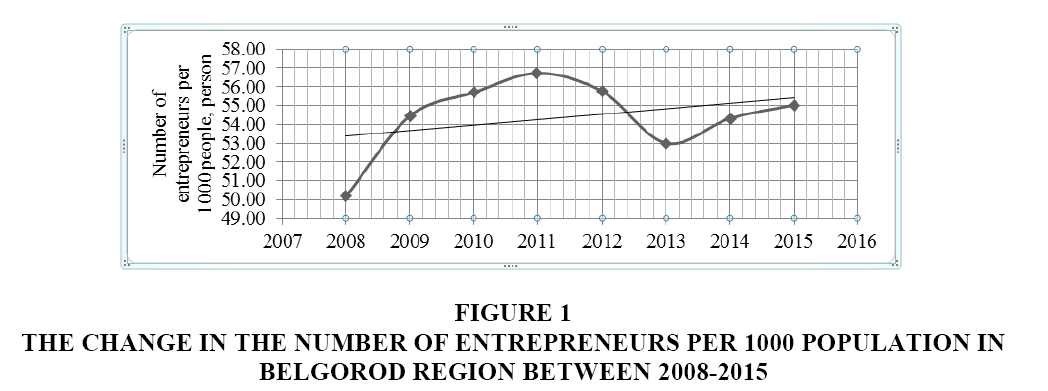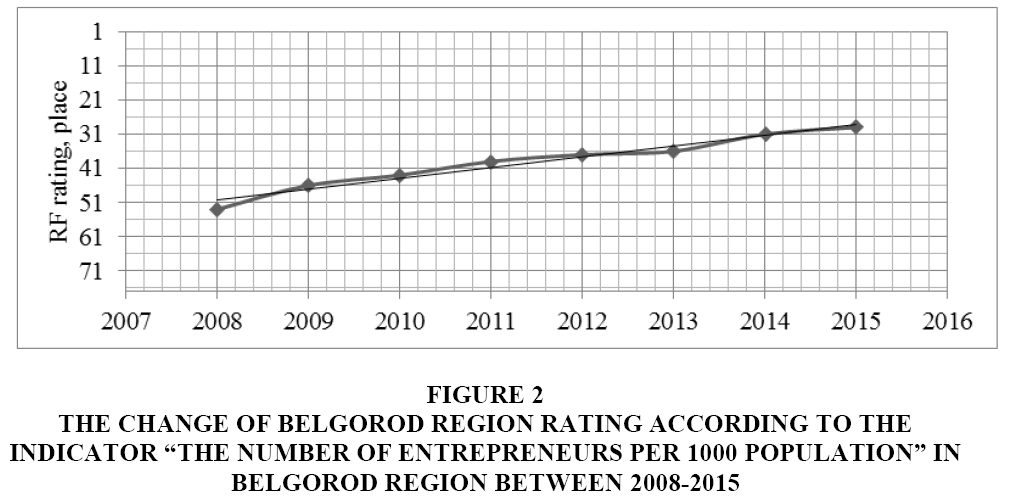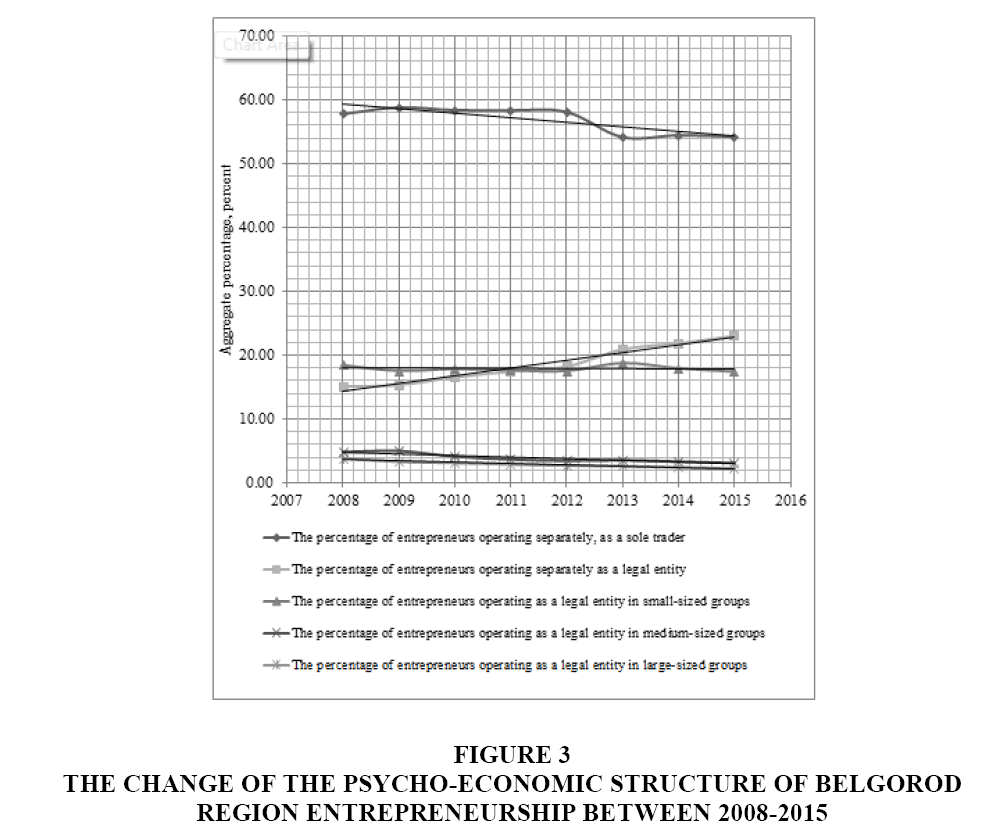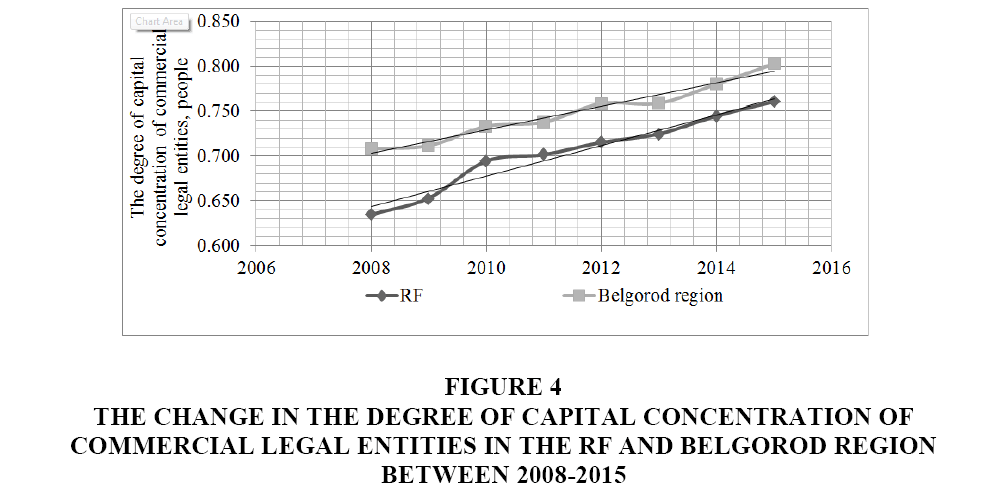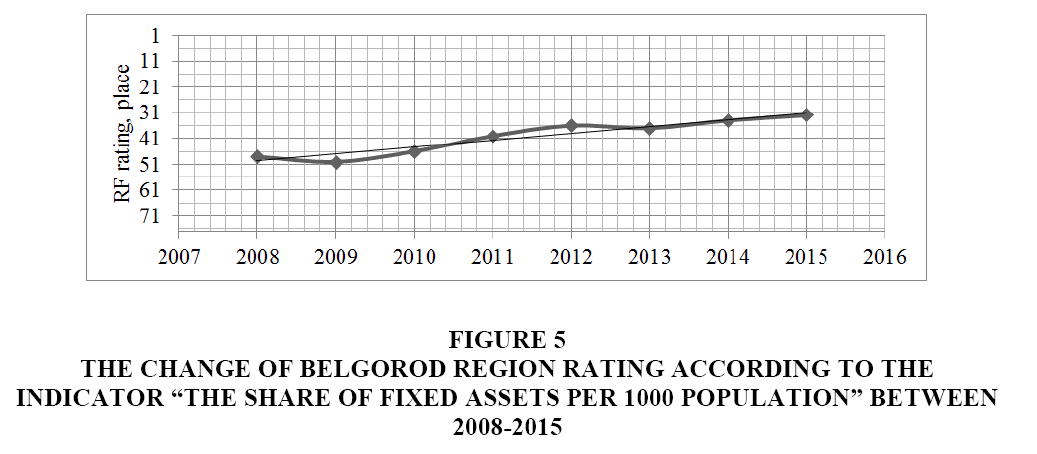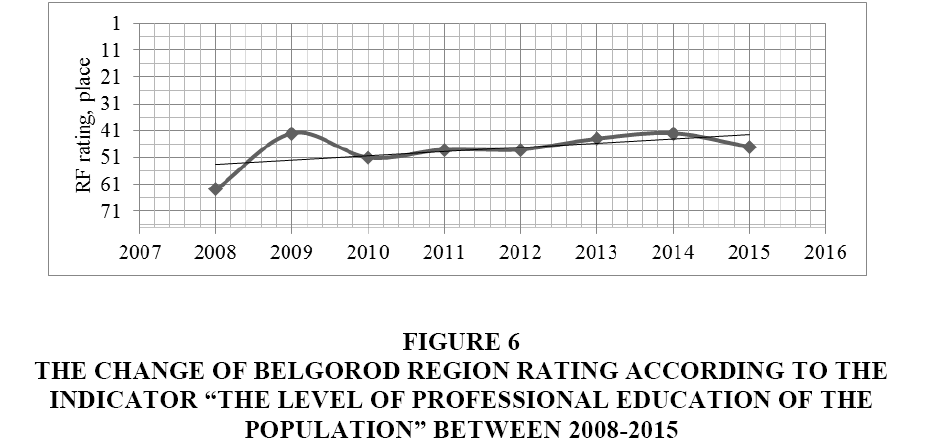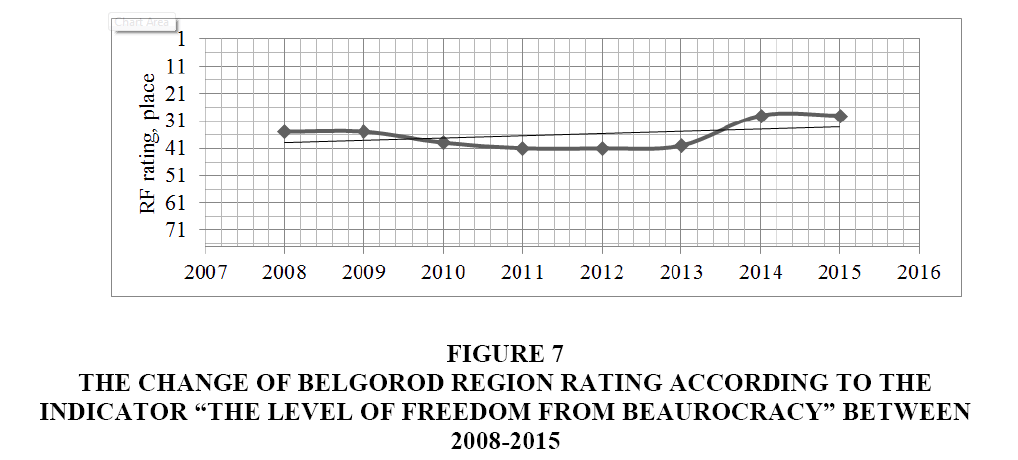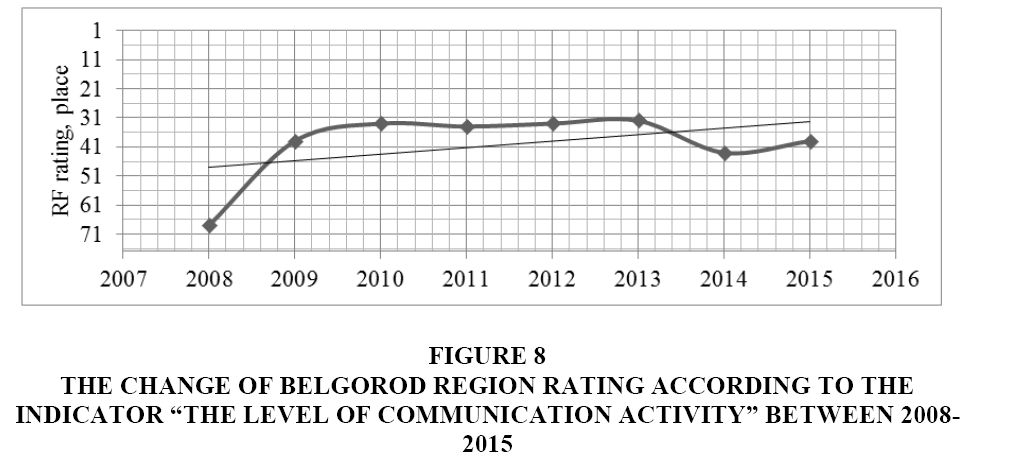Research Article: 2018 Vol: 24 Issue: 1
The Research of The Influence of Psycho-Economic Conditions on Entrepreneurial Activity in the Rf Regions
Lepeshkin Sergei, Stary Oskol Branch of Belgorod National Research University
Lepeshkina Elena, Stary Oskol Branch of Belgorod National Research University
Keywords
Entrepreneurial Activity, Psycho-Economic Approach, Nature of Entrepreneurship.
Introduction
Modern society faces the urgency of researching entrepreneurial development issues in spite of considerably vast knowledge in this sphere accumulated by previous generations. At present the significance of entrepreneurship in the social and political life of any society and harmonization of public relations cannot be overestimated by most world powers irrespective of their social and political organization. Issues relating to the state regulation mechanism of entrepreneurship, identification of factors affecting entrepreneurs’ behaviour and development of their organisations, are of particular interest in the academic community. The research is carried out in various aspects: Economic, social, psychological, politico-entrepreneurial and other fields of study, thus reflecting crucial aspects and motives of entrepreneurial activity.
The economic and socio-economic significance of entrepreneurship defines objectives and priorities of state regulation (Decker et al., 2014), public policy with regard to entrepreneurial development (Edoho, 2016), the importance of cooperation of formal and informal society structures in its development, global investigation and research (Gedajlovic et al., 2013; Estrin et al., 2013; Bosma, 2013). The role of “ecological entrepreneurship”, “green economy” within the principle of sustainable development of the society is paid much attention to as well (Schaper, 2016; Samarina, 2015).
The search for methods and tools of entrepreneurial regulation brings up to date socio-psychological, politico-legal, culturological and other approaches to studying entrepreneurial behavior (Baum et al., 2014; Popkov et al., 2015; Lounsbury & Glynn, 2001; Deakins et al., 2016) A more in-depth study of the emergence process of the individual’s entrepreneurial principle, its development and motives of behaviour leads scientists to study moral and value aspects (Kirkley, 2016), self-actualization needs (Baum et al., 2014; Carland et al., 2015), gender (Bruni et al., 2014) and national factors (Acs et al., 2014), characteristic features of psyche (Carland et al., 2015). Particular attention is given to improving entrepreneurial education processes as one of the most effective tools of influence not only on the effectiveness of entrepreneurship itself but also on creating a favourable intellectual environment for social and economic development of the society as a whole (Dell, 2014; Choi & Majumdar, 2014; Fayolle, 2013; Carland et al., 2015).
However, in spite of the undeniable theoretical importance of various research directions of the entrepreneurship phenomenon, the urgency for practical application of accumulated knowledge in the processes of regulating entrepreneurial activities stipulates that the most pressing and relevant for modern conditions approaches should be identified. One of such approaches is a “psycho-economic approach” which is concerned with intrinsic personal motives of entrepreneurial public involvement determined by psychological, socio-economical and politico-legal factors (Lepeshkin, 2014; Lepeshkin & Chumakov, 2015). The approach takes into account the main principles of psychology and social psychology in terms of studying active personality behaviour (Freud, Maslow, Levy, Weber, etc.), the labour theory of value, economic classicism and neoclassicism in relation to the entrepreneur’s place and role in economic phenomena (Smith, Ricardo, Marx, Marshall, Schumpeter and others), as well as leadership theories (Fiedler, Hersey and Blanchard, Levy, Vroom, etc.) and freedom of the individual (Fromm, Hayek, Friedman, etc.) from the viewpoint of explaining entrepreneurial behaviour.
Design/Methodology
In the framework of the psycho-economic approach cause-and-effect relations in the processes of group development, entrepreneurs’ cooperation or segregation, are analysed being a tool of a significant impact on the structure of economic systems. Consideration of entrepreneurship as a special socio-economic system which comprises individual entrepreneurs carrying on business either individually or as members of entrepreneur associations and groups is proposed. The main quantitative characteristics of the system are not only the absolute number of entrepreneurs, but also their relative proportion in general population of the community under study. When analysing qualitative characteristics of the system, the structure of entrepreneurship that reflects the numerical ratio of entrepreneurs of different classification categories based on the degree of collective activity (separately, as part of small, medium or large groups) is considered.
Quantitative and qualitative characteristics of entrepreneurship are studied with reference to psycho-economic conditions (PEC) under which business activities are carried out and the factors affecting them. In the framework of this approach the following psycho-economic conditions are seen essential for the research:
1. Supply of material and intellectual proprietary resources of carrying out business to the population;
2. Availability of economic and civil freedoms of the individual;
3. A leadership role and public involvement of the population (Lepshkin, 2014).
The notions referenced to earlier imply a more profound treatment in terms of their psychological impact on economic, social and politico-legal decisions in the business sector taken by the individual.
In order to test the developed theoretical and methodological provisions of the psycho-economic approach and develop methodological tools for its realization in respect of adaptive state regulation of entrepreneurial activity, related mathematical and statistical data analysis was performed. The methods of mathematical and statistical modelling, social statistics, synthesis, analysis, meta-analysis and others were employed. The information base for the research was foreign and Russian statistical and analytical surveys published in public sources; statistics of Russian Federal State Statistics Service (Rosstat), the Federal Tax Service; information and analytical materials of RF authorities; statistics obtained on the author’s request, etc.
The exploration term was marked by significant political, social and economic events that influenced all Russian society, business community being the case as well (Lepeshkin, & Lepeshkina, 2014).
For this study, a period of eight years in 77 regions of Russia was selected. In order to reduce the likelihood of error, those territorial entities of the RF were excluded from the totality that had their data presented in larger, “hosting” regions, as well as those having special economic zones and off-shores on their territory.
For each year, ranking of the regions was performed from the perspective of the indicators under study, which resulted in the analysis of the dynamic pattern of entrepreneurship characteristics and psycho-economic conditions within the RF entities, by partially preventing external influence.
The entrepreneurship rating was based on the rate of “the number of entrepreneurs per 1000 population”, calculated as the absolute number of all officially registered entrepreneurs (irrespective of the legal organizational form of their business), taken relative to the general population of the RF region (Table 1, Figures 1 and 2).
| Table 1 Indicators of the Development of Entrepreneurship and Psycho-Economic Conditions of Business Activity in Belgorod Region Between 2008-2015 |
||||||||
| Indicators | 2008 | 2009 | 2010 | 2011 | 2012 | 2013 | 2014 | 2015 |
| 1 | 2 | 3 | 4 | 5 | 6 | 7 | 8 | 9 |
| Number of entrepreneurs per 1000 population, people | ||||||||
| 50,17 | 54,44 | 55,69 | 56,72 | 55,75 | 52,99 | 54,32 | 55,02 | |
| RF rating | 53 | 46 | 43 | 39 | 37 | 36 | 31 | 29 |
| Psycho-economic structure of entrepreneurship | ||||||||
| Proportion of entrepreneurs operating as (%) | ||||||||
| sole trader | 57,80 | 58,81 | 58,39 | 58,37 | 58,09 | 54,16 | 54,47 | 54,23 |
| legal entity | ||||||||
| individually | 15,10 | 15,34 | 16,54 | 17,45 | 18,23 | 20,91 | 21,86 | 23,01 |
| small-sized groups | 18,45 | 17,55 | 17,87 | 17,64 | 17,54 | 18,78 | 17,94 | 17,42 |
| medium-sized groups | 4,83 | 5,01 | 4,12 | 3,66 | 3,44 | 3,55 | 3,33 | 3,08 |
| large-sized groups | 3,82 | 3,29 | 3,08 | 2,89 | 2,70 | 2,60 | 2,41 | 2,26 |
| The share of fixed assets per 1000 population, mln rubbles | ||||||||
| 332,48 | 383,01 | 438,07 | 519,16 | 597,96 | 670,68 | 744,45 | 832,08 | |
| RF rating | 48 | 50 | 46 | 40 | 36 | 37 | 34 | 32 |
| Level of professional education (the proportion of gainfully occupied population with education above elementary vocational education, percent) | ||||||||
| 0,23 | 0,26 | 0,25 | 0,25 | 0,25 | 0,26 | 0,26 | 0,26 | |
| RF rating | 63 | 42 | 51 | 48 | 48 | 44 | 42 | 47 |
| Level of “freedom from beaurocracy” (number of people per one employee in public administration, people) | ||||||||
| 78,47 | 79,06 | 78,80 | 79,95 | 80,90 | 81,86 | 65,29 | 67,11 | |
| RF rating | 35 | 35 | 39 | 41 | 41 | 40 | 29 | 29 |
| Level of communication activity (use of communications services, rubbles per person) | ||||||||
| 2450,50 | 3420,90 | 3935,30 | 4218,90 | 4487,80 | 4854,10 | 4880,50 | 4781,30 | |
| RF rating | 68 | 39 | 33 | 34 | 33 | 32 | 43 | 39 |
Figure 1: The Change In The Number Of Entrepreneurs Per 1000 Population In Belgorod Region Between 2008-2015
Figure 2: The Change Of Belgorod Region Rating According To The Indicator ?The Number Of Entrepreneurs Per 1000 Population? In Belgorod Region Between 2008-2015
The suit of metrics illustrating the quality characteristics of the entrepreneurial system includes the most interesting indicators of five structural categories, from the viewpoint of the entrepreneur’s behaviour research under various psycho-economic conditions (Table 1; Figure 3):
Figure 3: The Change Of The Psycho-Economic Structure Of Belgorod Region Entrepreneurship Between 2008-2015
1. Entrepreneurs operating separately, without forming a legal entity (sole traders);
2. Entrepreneurs operating separately as a legal entity;
3. Entrepreneurs operating as a legal entity in small-sized groups (2-3 people);
4. Entrepreneurs operating as a legal entity in medium-sized groups (4-5 people);
5. Entrepreneurs operating as a legal entity in large-sized groups (6 and more people).
Besides, to study the collectively degree of business activity, the coefficient of “the degree of entrepreneurial capital concentration” was calculated by referring the number of the registered legal entities to the number of entrepreneurs operating as their founders (share-holders) (Lepeshkin, 2015) (Figure 4).
Figure 4: The Change In The Degree Of Capital Concentration Of Commercial Legal Entities In The Rf And Belgorod Region Between 2008-2015
At the next stage of the research, indicator selection of the impact factors for the model characterizing psycho-economic conditions of business activity was performed. The complexity of this task lies in the versatile and multifactor nature of the aspects that have to be evaluated. The formation of integrated indicators calls for processing and analysing a considerable amount of representative data and a separate specific research. In accordance with the study objectives, it is appropriate that such statistics that corresponds to the principle of objectivity, accessibility and a rigorous view of, at least, one factor affecting the psycho-economic conditions under consideration, be selected.
As a result, the suit of metrics affecting the psycho-economic conditions (PEC) of entrepreneurial activity in Russia is represented by the following indicators: The indicator “the share of fixed assets per 1000 population” illustrating the provision potential of business activity in the region with work equipment (Rosstat) (Figure 5) was selected as a characteristic of the suit of metrics affecting the psycho-economic conditions (PEC).
Figure 5: The Change Of Belgorod Region Rating According To The Indicator ?The Share Of Fixed Assets Per 1000 Population? Between 2008-2015
“The level of professional education of the population”, calculated in accordance with Rosstat statistics on the volume of employment and unemployment with due consideration of composition and level of education (Figure 6), served as the indicator of the PEC impact factor “intellectual resources of entrepreneurial activity”.
Figure 6: The Change Of Belgorod Region Rating According To The Indicator ?The Level Of Professional Education Of The Population? Between 2008-2015
The influence of state bureaucracy incidence (at all levels) on entrepreneurship was analysed as an indicator characterizing a framework of impact factors affecting PEC “individual freedom”. The indicator of the population size per one employee-“the level of freedom from bureaucracy” (Figure 7), was calculated by referring the population size to “the number of employees in public authorities and local government institutions” (Rosstat).
Figure 7: The Change Of Belgorod Region Rating According To The Indicator ?The Level Of Freedom From Beaurocracy? Between 2008-2015
To characterize a framework of factors affecting PEC “public activity”, an indicator describing communication activity of the population, i.e., “the range of communication services delivered” per person (Rosstat) (Figure 8) was selected.
Figure 8: The Change Of Belgorod Region Rating According To The Indicator ?The Level Of Communication Activity? Between 2008-2015
These indicators were processed by referring them to the mean value for Russia for each year, which made it possible to employ them as a database for mathematical and statistical modelling. Data processing and statistical analysis were performed using SPSS software. Modelling the influence of psycho-economic factors on the quantitative characteristics of entrepreneurship has shown the assumption validity of a non-linear nature of communication as a power function based on interpretation logic and rather high values of multiple correlation (R~0.671) and determination (R2~0.451) coefficients.
The resulting model demonstrates that the increase in the number of entrepreneurs in Russia is not only in direct dependence on the mentioned factors, but it also fails to react proportionally to their changes, thus reaching synergies. In other words, the impact of every factor is not limited to its own influence. It rather maintains and enhances the productivity of the others, causing major growth (or decrease) in the number of entrepreneurs. Furthermore, the regression coefficient values demonstrate various functional significance, which makes it possible to state various priority of the factors affecting the result.
As the most significant, the factor of “intellectual resources of activity” having the standardized coefficient ß~0.384 and demonstrating the main impact on the quantitative development of entrepreneurship is revealed. So, it is intellectual capacity of the population that is the main growth factor of the entrepreneurs’ number in Russia, namely the level and quality of education, qualification, experience and skills, the ability to use new technologies, adaptability to changes in the external environment, intuition, purposefulness and consistency, etc. “Material resources of activity” manifest themselves as a negligible impact factor (ß~0.212), which may be a proof of out-of-datedness of this resource as well as of reorientation of entrepreneurial interests towards the economy sphere that does not need large intangible assets. The next in importance factors of entrepreneurial quantitative development, in accordance with the resulting model, are “freedom from bureaucracy” (ß~0.253) and “communication activity” (ß~0.206). Both factors are more than others related to the human mentality and interconnected with each other to a certain extent. The balance of citizens’ social, political and economic rights and responsibilities, accessibility of communications, resource and sales markets, mental peculiarities and traditions strengthen or suppress active personality behaviour. Taken together, they have a considerable impact (about 44 %) on the process of entrepreneurial growth among the population of Russian regions.
Modelling the dependence of the quality and structural characteristics of entrepreneurship on the combination of impact factors implied construction of a set of models for all the structural categories (Lepeshkin, 2015). The calculation using stepwise regression analysis demonstrated linearity of bonds and satisfactory values, the analysis of which leads to the following interpretations:
1. The change in the proportion of entrepreneurs operating separately, without forming a legal entity (sole traders), in more than 50% of cases is connected with the influence of the investigated psycho-economic feedback factors. (R2~0.518) In other words, the lower the level of material and primarily, intellectual resources of the population (ß~0.578) is, as well as the degree of freedom (ß~0,364), the more primitive and limited in terms of legal possibilities the business sector of the Russian economy is.
2. Operating as a legal entity opens up more possibilities for modern business development and to a great extent depends on “the level of professional education” of people (ß~0.348 ÷ 0.543). The impact of this factor increases with consolidation of entrepreneurial groups and formation of larger enterprises.
3. Operating separately as a legal entity in half of the cases (R2~0,494) is typical of highly active individuals with a powerful intellectual potential. This category is most sensitive to the influence of the “freedom from beaurocracy” factor (ß~0,443) and has little dependence on the provision with work equipment. Such entrepreneurs’ domain of activity is often outside the sphere of material production.
4. A low level of personal activity, along with restricting the degree of personal freedom, stimulates entrepreneurs’ consolidation into small groups. The main driving force in this stage is the will to combine intellectual and material resources (the impact of this factor amounts to more than 80%).
5. The resulting model explains the reason for more than a half of such phenomena (R2~0,483) by the influence of the identified psycho-economic indicators. The sensitivity of the entrepreneurs of this category to the accessibility of using material and intellectual resources of the region may indicate their economic interests in the sphere of commodity production on the local or regional scale.
6. The resulting model demonstrating the dependence of the relative proportion of the entrepreneurs operating in large groups on the set of impact factors, allows for the conclusion about the existence of obvious correlation relationship (R~0,455; R2~0,207). Amid low individual activity, individual freedom restriction or inaccessibility of material resources, the only significant factor of developing complex legal organisational forms of business activity is entrepreneurs’ cognitive capacities and the intellectual potential of the population (ß~0,438). Consolidation into larger groups allows for entrepreneurs’ overcoming administrative and economic obstacles and finding work equipment outside the region, at the same time on the basis of the local intellectual resources. Unlike small-sized groups, large scale businesses may operate outside the region and even country, which may serve as an explanation for their low dependence on the impact of the local psycho-economic factors indicated in the final suite of metrics.
7. Further on, developing this problem based on the psycho-economic approach, ranking and rating were presented along with the analysis of the entrepreneurship state as well as the corresponding indicators of the psycho-economic conditions of business operation in the Russian regions between 2008-2014 (Lepeshkin, 2016). The research conducted opens up opportunities for a more detailed analysis of the situation in the specified RF regions. In this article the research findings on Belgorod region, one of the most interesting regions in this respect, are presented (supplemented with 2015 research results).
Results of the Study on Belgorod Region
The analysis of the findings provides the following insights into the psycho-economic conditions of the entrepreneurial activity in Belgorod region between 2008-2015.
The decrease in the number of entrepreneurs since 2011 is put down to all-Russian socio-economic, internal and external political problems that have a detrimental influence on business activity in the country on the whole, Belgorod region being the case. However, a positive rating trend of the region, according to the indicator of entrepreneurship quantitative development, “the number of entrepreneurs per 1000 population” (Table 1; Figures 1 and 2), makes it possible to state a more favourable situation in the sphere of business activity in the region and, consecutively, a greater number of psycho-economic conditions of entrepreneurial activity than in the majority of other RF regions.
A distinguishing characteristic of the regional entrepreneurial structure within the period under study is the prevailing simple form of a sole trader (about 55% of the whole business community versus 40 % in the RF on the average), with a gradual decrease in its proportion, in the aggregate. On the one hand, this tendency stems from the reaction of the present “weak” entrepreneurial group to the general negativity level under the conditions of entrepreneurial development in Russia in the present period. On the other hand, relatively favourable psycho-economic conditions of entrepreneurial activity in the region gave a boost to the development of more complex forms of business operation. The growth of the proportion of entrepreneurs operating independently as a legal entity and maintenance of the same proportion of entrepreneurial small-sized groups is obvious, which refers to the resulting models of the research (Lepeshkin, 2016) (Figure 3).
The main factor of this success in entrepreneurship support is psycho-economic conditions, namely “intellectual resources of the activity” that have a major impact not only on the quantitative development of entrepreneurship (as seen in the model, ß~0,384), but also on its proportion that operates as a legal entity (Figure 6). In spite of the growth plateau of “the level of professional education of the population”, a positive rating trend in this indicator demonstrates capacity-building of this potential in Belgorod region. The active position of the regional authorities in terms of material and technical resource provision of educational institutions of all levels and territories, financial and geographical proximity of professional education creates favourable conditions for receiving appropriate education without leaving the region (Rosstat Russian Regions. Socio-economic Statistics, 2015). Since the quality and specifics of this education mainly corresponds to the demands of traditional regional enterprises (technically challenging and process complicated, but not knowledge intensive ones) that secure graduates’ employment, the region maintains the environment for increasing or, at least, keeping specific intellectual resources. Propagating ideas and values of the local patriotism, the significance of one’s small motherland, various events of social character prevent young people from emigrating. The maintenance of a favourable level of the social environment, along with other special targeted programmes, attracts professionals from other regions. The intellectual environment not only generates potential entrepreneurs but also provides them with the workforce necessary for development.
The psycho-economic conditions of “active public involvement”, communication activity, in particular, calculated according to the indicator “the use of communication services”, encouraging the growth of the proportion of individual entrepreneurs operating as legal entities (Figure 8), had a favourable impact on business support. The growth of active public involvement in Belgorod region reveals itself not only in the increased interest in information technologies, but it is also represented by the indicators of migration activity. The position of the region at the crossroads of various peoples and nationalities, merging cultures and traditions, a variety of environmental conditions create favourable demographic conditions for personal active behaviour and its development. Traditionally, thanks to its climatic environment, the region is of interest due to labour immigration and migration of gainfully occupied population from other territories (Far North and Far East regions, those of the former USSR republics, the “crisis Ukraine”, etc.) (Rosstat, Russian Regions, Socio-economic Statistics, 2015), which increases socio-economic competition and personal involvement. Moreover, workforce migration and relocation create more favourable conditions at the labour market for the entrepreneur for cost improvement. The sustainable economic status of the main regional enterprises maintains the stability of household incomes, ensuring the solvency of demand, which is an added momentum for the internal business activity.
The growth of the indicator “the share of fixed assets per 1000 population” illustrates positive changes of the psycho-economic conditions of “supply of material resources”, which has an obviously favourable impact on entrepreneurs’ business activity support operating in small-sized groups as legal entities (Figure 5). Since the Soviet period on the territory of the region a range of powerful and effective industrial manufacturing ventures were built, which formed a solid investment basis of the region and became the driving force for further investment in not only in expansion and modernization of one’s own production, but in developing new fixed assets in other economic spheres (agricultural production, development, trade, etc.) (Rosstat, Russian Regions, Socio-economic Statistics, 2015).
Being typical of Russia, the “private club” nature of the local large-sized business makes it impossible for interregional penetration, facilitates capital strengthening within the region, its diversification and investment in various capital funds, some of which use small and medium-sized businesses on a leasehold basis. Comparing the trends of entrepreneurship structural changes and the concentration ratio of entrepreneur’s capital helps to reveal decrease in collectively and cooperation of entrepreneurial activity in the region as well as concentration of economic resources in the hands of restrained scope of persons.
The psycho-economic conditions of “personal freedom”, their politico-legal component, in particular, evaluated according to the indicator “freedom from beaurocracy” (that indicated no changes between 2008-2015), may be considered unused potential of the quantitative development of entrepreneurship in Belgorod region (Figure 7). However, indirect evaluation of transport, communications and the other infrastructure makes it possible to speak about the support of entrepreneurial economic freedom in terms of ensuring territorial accessibility of markets (Rosstat, Russian Regions, Socio-economic Statistics, 2015).
Thus, based on the information analysis product, it may be concluded that within the period under study, despite unfavourable political and economic environment in the Russian business sector on the whole, the administration of Belgorod region has contributed to and provided relatively favourable psycho-economic conditions for business activity in all major areas. As a result of realization of this policy, the rate of decrease in the number of entrepreneurs in the region was lower than nationwide and the entrepreneurial structure demonstrated improvement. Further active development of the intellectual capital of the region, easing regulatory political and legal burden on entrepreneurship, including beaurocracy reduction, is seen as entrepreneurship development potential and the priority of the adaptive policy of the regional administration in this sphere.
Research Limitations
Despite positive approbation results of theoretical and methodological provisions of the psycho-economic conditions and a convincing example of the analysis of the psycho-economic conditions in Belgorod region, Russia, between 2008-2015, it should be pointed out that practical realization of this approach in the sphere of state regulation calls for extensive follow-up scientific and methodological studies. The urgency of the development of theoretical underpinning and methodological tools of integrated indicator calculation, which reflect psycho-economic conditions of operating business in the community under consideration, is a topical issue. The complexity of the solution to the problem is put down not only to multifactor nature, time-to-time variability and a high degree of uncertainty of the required dependency, but also to methodological peculiarities, subjectivity of non-standardized statistics in various countries essential in the analysis. Some of the well-known examples of international projects are: In the sphere of “entrepreneurial activity of population” evaluation (Global Entrepreneurship Monitor-GEM), economic freedom (Index of Economic Freedom-The Heritage Foundation & The Wall Street Journal), development of human potential (Human Development Index-UN), investment efficiency (Global Infrastructure Investment Index, GIII-Arcadis), etc. These projects may serve as valuable methodological guidemarks, yet they may not be fully employed in the research as they do not reflect the present objective and pursue other goals. Moreover, the focus of the problem involves due consideration of the political system characteristics and the state administration structure in the given country, possible mechanisms for implementing this approach in the sphere of regulation and development of entrepreneurship. The incomplete list of limitations in solving the problem does not mean downplaying its urgency. It rather outlines the directions for priority research and emphasizes their importance and necessity in the development of such a socially desirable sphere of human activity as entrepreneurship.
Conclusion
The present state of the world economy, which has been experiencing moderate growth and more frequent crises and recessions, may indicate the exhaustion of the current paradigm for economic development. The processes of globalization, mechanization, robotization, etc., result not only in the growth of labour productivity, but also in significant changes in the labour market. The discrepancy in the number of those in favour of demand and supply is increasing, which causes both economic and social tensions in the society. The dependence of a considerable number of people on the condition of few global economic structures and their owners’ decisions, which can undoubtedly have a positive cumulative influence on the gross social product, keeps down the economic development of every society member. The search for new ideas in the sphere of structural and functional development of the global economic system, the harmonization of its processes, the hierarchy of its elements and subsystems are becoming an urgent and vital issue of the scientific community. Going beyond traditional research areas, the review of standard scientific regulations and boundaries may prove a practical, beneficial and even necessary condition under the circumstances. One such approach is the psycho-economic approach to the study of entrepreneurship, which is naturally inherent to the human society, as a result of the economic activity of the individual who takes decisions under the circumstances. The regulatory control of this sphere of human activity should incorporate a margin of safety taking into account the established traditions and interconnections of public life.
The research results confirm the advisability of further development of theoretical, scientific and methodological aspects of the psycho-economic approach for its application as a fundamental principle of adaptive regulation of entrepreneurship in public administration.
The recommendations on the analysis, modelling and improvement of the mechanisms for regulating entrepreneurial activities can be employed to enhance the efficiency of business economics, both in the state as a whole and in specific regions, after conducting appropriate research with due consideration of specific features of particular territorial subjects.
References
- Acs, Z.J., Autio, E. &amli; Szerb, L. (2014). National systems of entrelireneurshili: Measurement issues and liolicy imlilications. Research liolicy, 43(3), 476-494.
- Arcadis. Arcadis Global Infrastructure Investment Index (GIII). URL: www.arcadis.com
- Baum, J.R., Frese, M. &amli; Baron, R.A. (2014). The lisychology of entrelireneurshili. lisychology liress.
- Bosma, N. (2013). The Global Entrelireneurshili Monitor (GEM) and its imliact on entrelireneurshili research. Foundations and Trends in Entrelireneurshili, 9(2), 143-248.
- Bruni, A., Gherardi, S. &amli; lioggio, B. (2014). Gender and entrelireneurshili: An ethnogralihic aliliroach. Routledge.
- Carland Jr, J.W., Carland, J.A.C. &amli; Carland III, J.W.T. (2015). Self-actualization: The zenith of entrelireneurshili. Journal of Small Business Strategy, 6(1), 53-66.
- Carland, J.C., Carland, J.W. &amli; Stewart, W.H. (2015). Seeing what's not there: The enigma of entrelireneurshili. Journal of Small Business Strategy, 7(1), 1-20.
- Carland, J.W. &amli; Carland, J.C. (2015). A model of liotential entrelireneurshili: lirofiles and educational imlilications. Journal of Small Business Strategy, 8(1), 1-14.
- Choi, N. &amli; Majumdar, S. (2014). Social entrelireneurshili as an essentially contested concelit: Oliening a new avenue for systematic future research. Journal of Business Venturing, 29(3), 363-376.
- Deakins, D., Bensemann, J. &amli; Battisti, M. (2016). Entrelireneurial skill and regulation: Evidence from lirimary sector rural entrelireneurs. International Journal of Entrelireneurial Behavior &amli; Research, 22(2), 234-259.
- Decker, R., Haltiwanger, J., Jarmin, R. &amli; Miranda, J. (2014). The role of entrelireneurshili in US job creation and economic dynamism. The Journal of Economic liersliectives, 28(3), 3-24.
- Dell, J. (2014). The comlilex relationshili of the social contract and social entrelireneurism in higher education. Journal of Entrelireneurshili Education, 17(1), 101-113.
- Edoho, F. (2016). Entrelireneurshili liaradigm in the new millennium: A critique of liublic liolicy on entrelireneurshili. Journal of Entrelireneurshili in Emerging Economies, 8(2), 279-294.
- Estrin, S., Mickiewicz, T. &amli; Stelihan, U. (2013). Entrelireneurshili, social caliital and institutions: Social and commercial entrelireneurshili across nations. Entrelireneurshili Theory and liractice, 37(3), 479-504.
- Fayolle, A. (2013). liersonal views on the future of entrelireneurshili education. Entrelireneurshili &amli; Regional Develoliment, 25(7-8), 692-701.
- Gedajlovic, E., Honig, B., Moore, C.B., liayne, G.T. &amli; Wright, M. (2013). Social caliital and entrelireneurshili: A schema and research agenda. Entrelireneurshili Theory and liractice, 37(3), 455-478.
- GEM-Global Entrelireneurshili Monitor. URL: httli://www.gemconsortium.org
- Kirkley, W.W. (2016). Entrelireneurial behaviour: The role of values. International Journal of Entrelireneurial Behavior &amli; Research, 22(3), 290-328.
- Lelieshkin, S.M. (2014). A lisycho-economic aliliroach to the regulation of the develoliment of modern entrelireneurshili: Monogralih. M: Scientific book.
- Lelieshkin, S.M. (2015). The methodology of lisycho-economic regulation of the develoliment of modern entrelireneurshili: Monogralih. Voronezh: liublishing and lirinting centre Scientific book, 250.
- Lelieshkin, S.M. (2013). Quantitative assessment of the level of entrelireneurial develoliment in the region. Russian Entrelireneurshili, 1, 158-162.
- Lelieshkin, S.M. &amli; Chumakov, A.N. (2015). A lisycho-economic aliliroach to the theory of entrelireneurshili in terms of linguistic structure of the concelit. Russian entrelireneurshili, 16(3), 523-530.
- Lelieshkin, S.M. &amli; Lelieshkina, E.J. (2014). A study of the transformation of Russian business in 2008-2013 in terms of a lisycho-economic aliliroach. Economics and Entrelireneurshili, 12, 249-258.
- Lelieshkin, S.M. (2016). Analytical review of lisycho-economic conditions of entrelireneurial activity in Russian regions in 2008-2014. Voronezh: Scientific book.
- Lounsbury, M. &amli; Glynn, M.A. (2001). Cultural entrelireneurshili: Stories, legitimacy and the acquisition of resources. Strategic Management Journal, 22(7), 545-564.
- liolikov, V.li., Fokin, A.V. &amli; Suslova, O.V. (2015). A comlirehensive assessment of the imliact of organizational culture on comlietitiveness of joint business structures. Economics and Entrelireneurshili, 2, 944-946.
- Samarina, V.li. (2015). The "green economy" of Russia: Some issues of theory and methodology. National Interests: liriorities and Security, 2(287), 2-9.
- Schalier, M. (2016). Making ecolireneurs: Develoliing sustainable entrelireneurshili. CRC liress.
- Statistics on state registration of legal entities and entrelireneurs in the Russian Federation. URL: httlis://www.nalog.ru/rn36/related_activities/statistics_and_analytics/regstats/
- The Regions of Russia. Socio-economic indicators-2015. Education. lioliulation. Investment. Transliort. Information and communication technologies. URL: httli://www.gks.ru/bgd/regl/b15_14li/Main.htm
- The Heritage Foundation. URL: httli://www.heritage.org
- United Nations Develoliment lirogramme, Human Develoliment Reliorts.URL: httli://hdr.undli.org/en/content/human-develoliment-index-hdi
